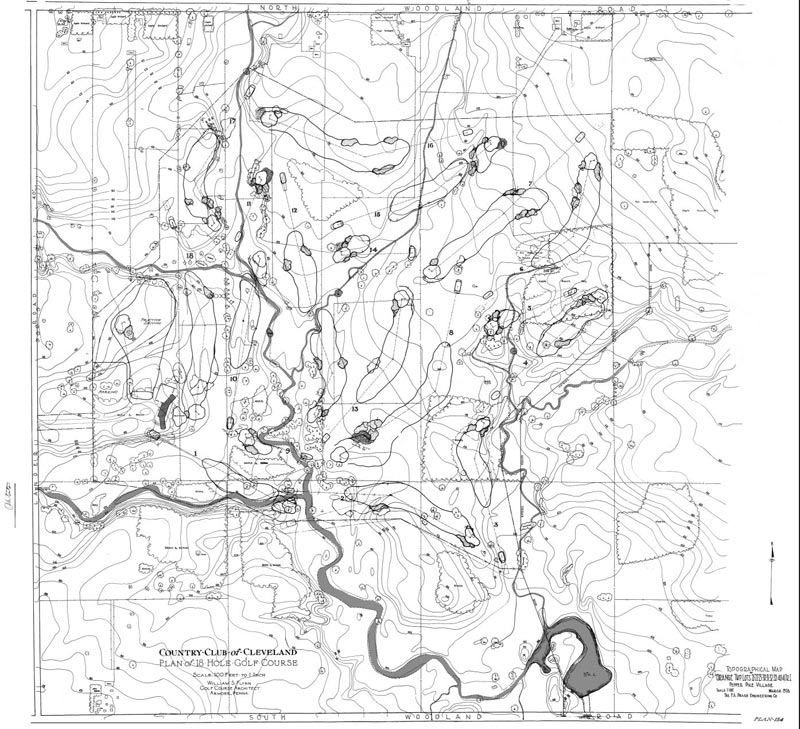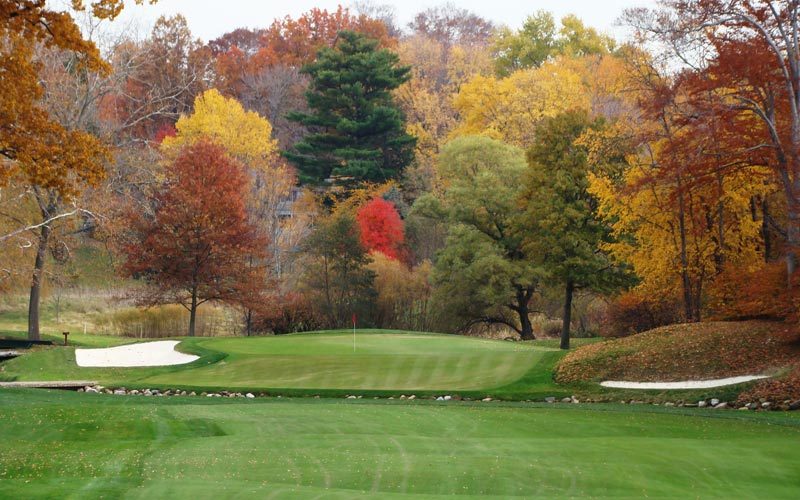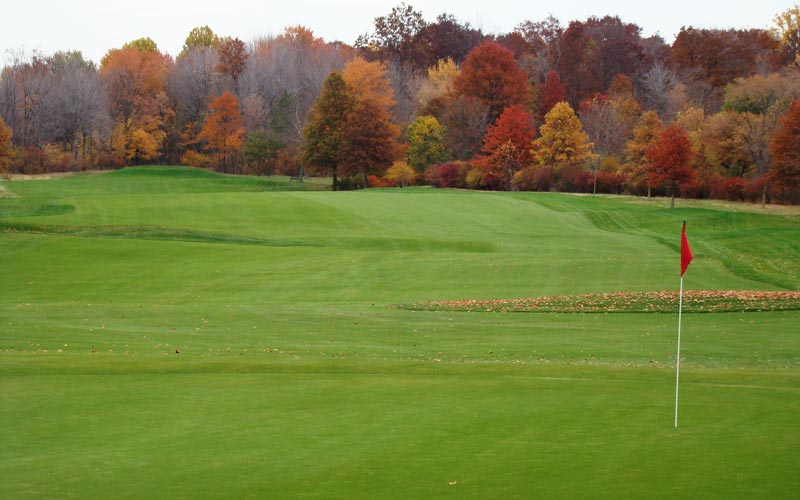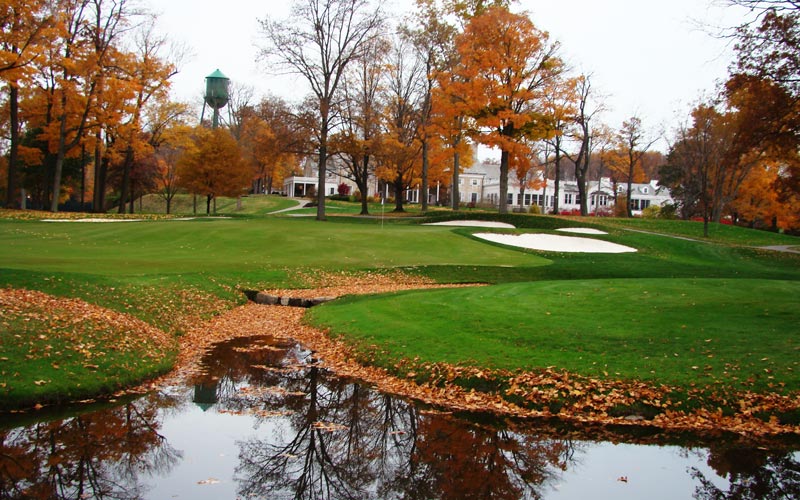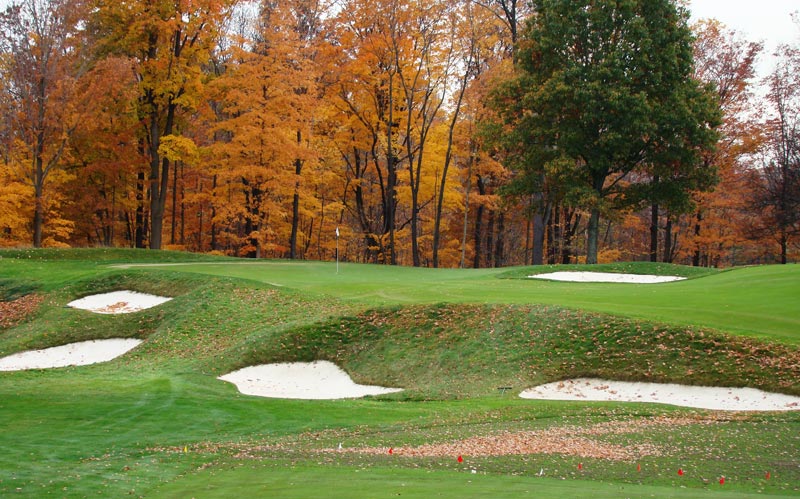The Country Club
Pepper Pike, OH, USA
Green Keeper: Brian Mabie
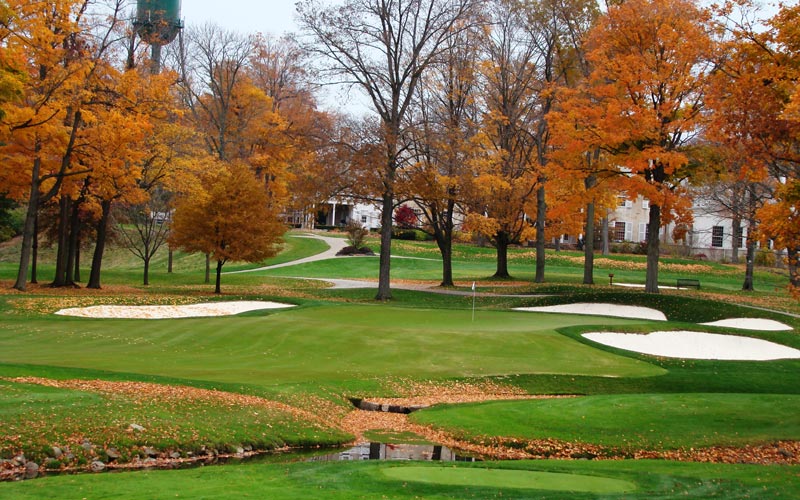
The Country Club at Pepper Pike features an old time charm that harkens back to the Golden Age of golf course architecture.
The Country Club outside of Cleveland traces the evolution of the game of golf as well as any club in America. Originally founded in Glenville near Lake Erie in 1889, the purpose of The Country Club as defined by one of its founders Samuel Mather was to provide a country retreat for wealthy Cleveland citizens. Be it horseback riding or picnics, the original one hundred members enjoyed the chance to get into the great outdoors and away from Cleveland’s industrial center. A visit by Mather to St. Andrews Golf Club in Yonkers, New York in 1895 provided a strong impetus to incorporate golf into the pastoral offering and shortly thereafter, a nine hole course was created. In 1902, The Country Club’s own Coburn Haskell played a pivotal role in shaping the direction of the game when he invented the rubber wound ‘Haskell’ ball with a rubber core with aid from the nearby B.F. Goodrich Company.
Much more so than when steel shafts replaced hickory ones, the advent of the Haskell ball dramatically changed how the game was played. New eighteen hole courses for clubs with high aspirations for hosting events went from being built in the 6,000 yard range to 6,600 yards within the first decade of the advent of the Haskell ball. As that relates to The Country Club’s own evolution, it had already become an eighteen hole course but Cleveland’s industrial might had expanded east and engulfed the surrounds of the property. The very essence of escaping into the country had been lost. The solution to this problem came in an offer from the Van Sweringen brothers, assemblers of a railroad empire and creators of the community of Shaker Heights. In 1928, the brothers proposed that The Country Club relocate to their new Pepper Pike development with the promise of a large parcel of land and a loan with which to build a new clubhouse.
Though the new location for The Country Club didn’t feature the strong landforms at Mayfield or an in-your-face moment like the approach to the fifteenth at Canterbury, its property was expansive and featured a creek running through its rolling grounds. The high to low point on two-thirds of the hole is fifteen feet or more and the highlights come when master architect William Flynn incorporated the most interesting landforms into the holes themselves when he built the course in 1928. Examples include the creek at the ninth, the terraced fairway at the fifteenth and the roll-a-coaster ground movements of the seventeenth fairway. To be considered great, a course must have great holes and these are those at The Country Club.
However, it is the unrelenting strength of the supporting cast that makes The Country Club strong top to bottom. If that makes it sound like an Oak Hill or Medinah, it’s not meant to as this course features approach shots that are more varied in regards to how the approach shots set up and the views that are offered of the greens. Simply put, there is no guarantee that the golfer will have a good view – or any view for that matter – of the putting surface on nearly half the holes. Sometimes, greens are perched high like at the eleventh while others are hidden behind cross-hazards like the eighth. The greens at two brutish par fours, the sixth and fifteenth, feel almost more like links holes as they are found respectively beyond the brow of a hill and a ridge. At the 585 yard twelfth, if the golfer doesn’t manage to get his first two shots within 120 yards of the green, a hillock ensures his third will be to a blind target. This true lay of the land architecture and as a result, the holes are distinctive and the course doesn’t readily remind one of any other. This is a great compliment as most other parkland courses can blur together in one’s mind. Not here.

The game is still played by feel at The Country Club as the golfer doesn’t always enjoy a full view of its greens, including the fifteenth as seen (not seen!) from the lower portion of the fairway.
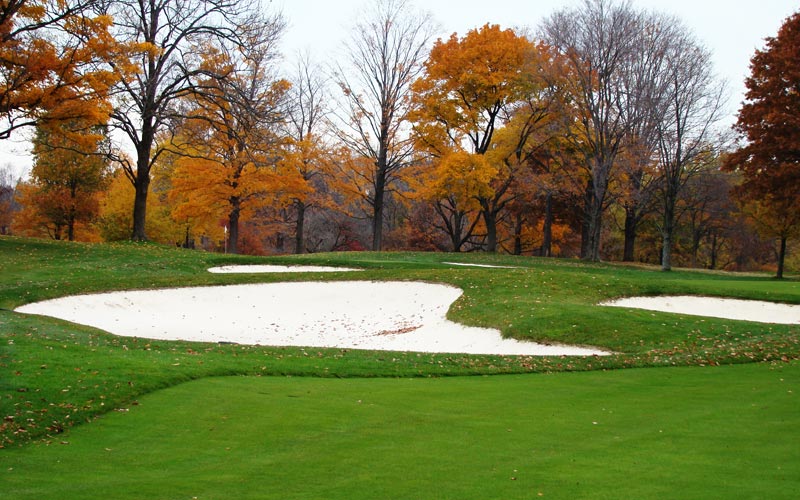
Even on the less rolling part of the property, note how the putting surface at the thirteenth is obscured from view from the inside of the dogleg. Only by playing to the outside of the dogleg where the ground is slightly higher does the golfer gain a better view of the green. Such subtle nuances like this make Flynn courses a delight to play again and again.
Being given expansive property is a great luxury for any architect. In the case of The Country Club, William Flynn took full advantage of the nearly 300 acres of rolling ground as seen in several ways. First, the holes enjoy a spacious quality to them and Flynn routed the holes so that they fall over the landforms in varying ways. Flynn never got boxed in as sometimes happens to architects on tight property and as a result, there is nothing approaching a weak or indifferent hole. In addition, when it came time to expand the course past the 6,800 yards that it was when Flynn left the property, there was plenty of room to add back tees which actually reduced some of the green to tee walks. Finally, though eight of the holes brush along the perimeter of the property, there is plenty of room still between the playing corridors and the out of bounds so that the golfer enjoys a round that is free from outside intrusions.
Hence, it is no surprise that from the day Flynn’s course opened on August 10th, 1930, The Country Club built a strong reputation. Lawson Little won the British and United States Amateurs in consecutive years, completing his ‘Little Slam’ at The Country Club in 1935. However, as has been demonstrated at a majority of Golden Age courses in the United States, time can be cruel and unnecessary changes took place to Flynn’s sterling design. Aerials from the 1960s and forward show fairway width being compromised by tree growth and greenside bunkers being added ostensibly to ‘tighten’ the approach shot requirements. Rock outcroppings were added where the creek snaked through the ninth and tenth holes.
By the late 1990s, the balance between fun and challenge had shifted too far toward just asking the golfer to execute rifle straight shots. Flynn, who is one of the all-time masters at creating interesting playing angles, would have scowled should he have stood on the first tee and looked out at what had become a scant twenty-one yard wide fairway. And that to a fairway with interesting undulations and movement! When conditions were fast and firm, just holding the fairway was a minor miracle, let alone trying to place it down one side or the other off the first tee. Thankfully, Flynn’s great routing was never tainted and the property with its large buffer against the outside world had not been compromised.
Realizing that something needed to be done, The Country Club turned to Brit Stenson of IMG Design. Unlike almost all of his projects, this one had two great attributes going for it from the start. First, The Country Club possessed the set of Flynn’s drawings for each of the eighteen holes. No guess work was required as to Flynn’s design intentions. Second, this project was in Stenson’s backyard and it enabled him to be there nearly every day once the work commenced with Macdonald & Sons as shapers.
Here is what former club champion J.T. Taylor says about the work that was carried out in 2002:
While I have truly enjoyed the golf course for many years, the transformation that occurred with the renovation was nothing short of spectacular. The best changes that occurred with the renovation were (1) the return of the original fairway widths which, while making it easier to hit fairways, also forced the lazy driver of the golf ball to make up for his or her carelessness with a much tougher angle of approach into many greens, and (2) the elimination of multiple greenside bunkers (right of 4th green, left of 7th green, right of 8th green and right of 10th green) which were replaced with fairway-length grass which has made the types of recovery shots infinitely more interesting. There is nothing more enjoyable than walking to a missed approach shot next to one of these greens with a lob wedge, sand wedge, putter, three wood and eight iron and trying to “see” the proper shot to be played. This is much more interesting that stepping into a bunker with a sand wedge. For me, the true test of a great club is how anxious you are to get back again to play it and I can tell you that every day I look forward to returning to play it again.
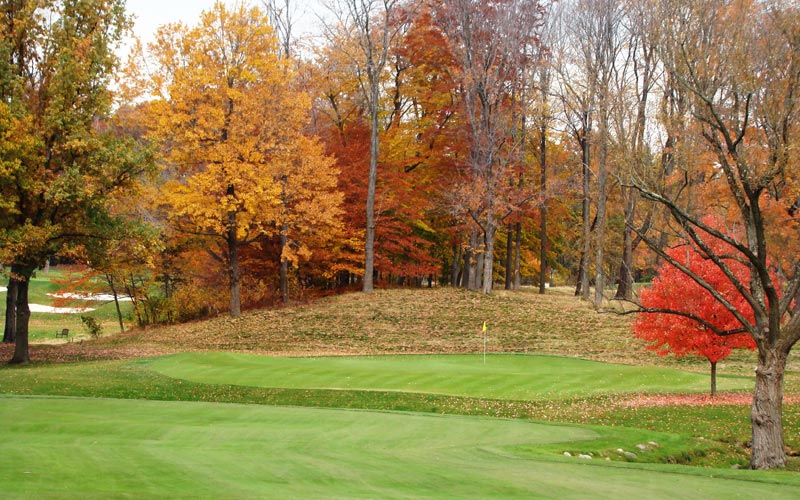
There once was a bunker to the right of the tenth green but no more – the golfer must now contend with a tight lie for his recovery shot. Flynn’s front right hump makes such shots problematic.
In addition to Stenson’s work, the addition of Brian Mabie from the Firestone complex as green keeper proved a key component to restoring the course to its rightful place among the best parkland courses in the United States. Since late in 2007, Malbie has helped to oversee a selective tree clearing program which has opened up long vistas across the gorgeous property. In addition, he has hydro-seeded selective areas to introduce varying grasses that enhance the course’s texture, avoiding the plight that too many parkland courses endure of washing out to the eye by offering little contrast other than shades of green. Furthermore, the fast and firm conditions that Malbie promotes exacerbate the conundrum that the golfer faces at some of the tight chipping areas around the greens, as noted by Taylor above.
Two yardages are listed below in the Holes to Note section. One is from the back tees, which stretches this Golden Age course to over 7,100 yards and the other is from the more reasonable 6,600 yard set. The fact that the course was effortlessly stretched past 7,000 yards is poetic justice and a tip of the hat to Coburn Haskell as well as to The Country Club‘s wise decision in the late 1920s to move to such an expansive site.
Holes to Note
First hole, 360/345 yards; Meandering creeks are fabulous hazards but most golf architects rarely are given the chance to work with them. By good fortune, an unusually high percentage of sites upon which Flynn worked feature creeks (Lancaster, Huntingdon Valley, Rolling Green, Lehigh, The Cascades, etc.). As The Country Club was built around the mid-way point of Flynn’s career, he knew just how best to integrate the creek that wanders across the property into several holes. Given changes in technology as well as its elevated tee, the first hole would be in danger of losing its playing integrity if not for the creek but as it is now, the first hole can see a group of four each reach for a different club off the tee.
Third hole, 340/315 yards; The Country Club and Stenson religiously followed Flynn’s hole sketches when they embarked on this restoration project. The one exception came here at the third green complex where they decided to widen the green from back to front and extend it farther to the right. This was a wise move as several risk reward right hole locations were picked up in the process.

Though the work in 2002 made today’s hole location a more accessible target by virtue of widening the green, note the new right ones that were created. The green now protrudes farther right and features sharp drop-offs short and right.
Fourth hole, 380/350 yards; Regardless of a hole’s length, most uphill holes designed during the Golden Age prove to be challenging, generally because it provides an ideal opportunity to build a green with great character. Such is the case here with the fourth green containing some of the best interior contours on the course. In an interesting variation, William Flynn‘s large bunker angling into the fairway created fine playing angles on this hole as well.
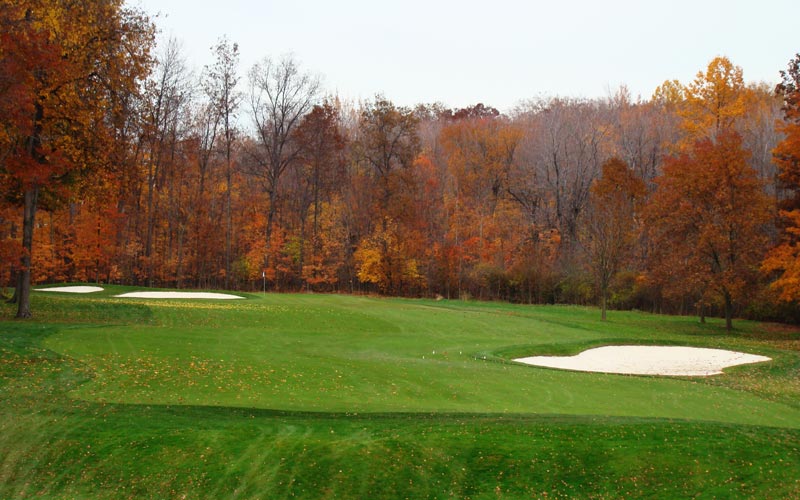
The golfer dearly loves to approach the fourth green from the right side of the fairway, just past where the bunker intrudes into the fairway.

Those not familiar with the eastern suburbs of Cleveland are often shocked to learn just how well suited the ground is to thrilling golf. This is the view back toward the fourth tee.
Seventh hole, 505/460 yards; Stenson did a particularly fine job over the next two holes at pulling Flynn’s hazards back into play. Here at the seventh, a large bunker protrudes well into the fairway exactly where big tee balls love to finish. It drives some of the best golfers at The Country Club crazy and no wonder: an aerial from the 1970s that hangs in the men’s locker room shows how the seventh fairway was once clear sailing with the hazards pushed to the sides. As in Flynn’s day, the golfer is once again asked to think. In addition, his appreciation for golf as a ground game sport is increased as he needs to be mindful of how the ground will impact the result on both his tee ball and approach shot.
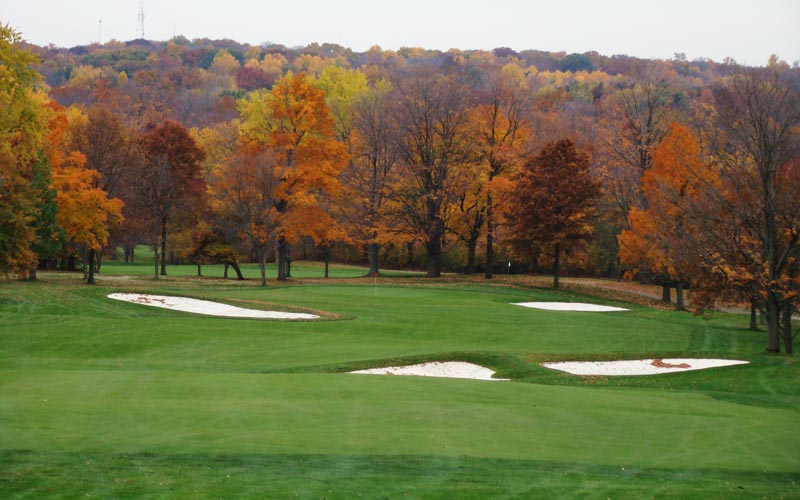
Looking down the long seventh from the tee, life would be great if that fairway bunker wasn’t in the way! Note how the fairway dips and helps to send tee balls into it.
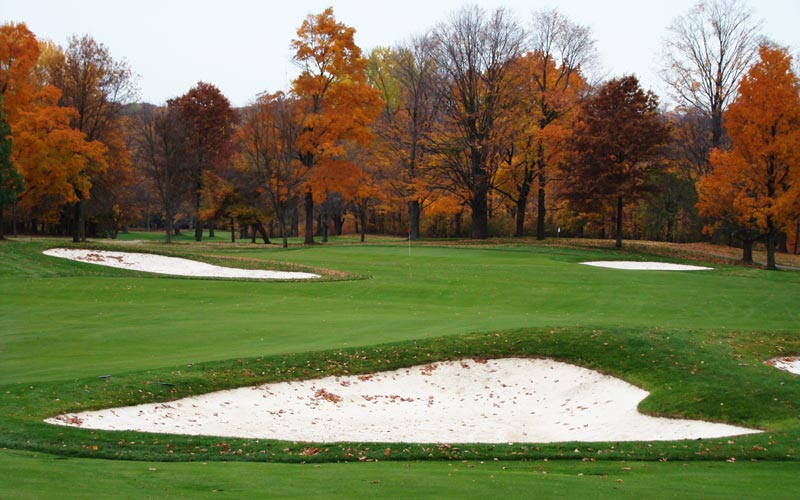
This view is from 220 yards out with the left bunker up ahead a good thirty yards from the putting surface. Everything about the seventh is on a grand scale and in many ways, it best captures the spaciousness that has been restored in the past several years.

Great golf isn’t complicated and golfer is free to select how he would like to play his approach into the open seventh green.
Eighth hole, 570/530 yards; More so than most Golden Age architects, Flynn believed in the use of trees to guard the playing value of holes. At some point in the 1960s, trees were removed at the crest of the hill and an ameba shaped bunker was built 250 yards out from the eighth tee to protect the inside on this dogleg right. As part of the restoration, the bunker was taken out, trees were planted and more importantly, an immense central hazard was re-established 100 yards from the green. Yes, it was out of play for Sergio Garcia when he coolly hit a six iron into the green in two recently but for 99% of club golfers, this bunker complex dictates the hole’s strategy.
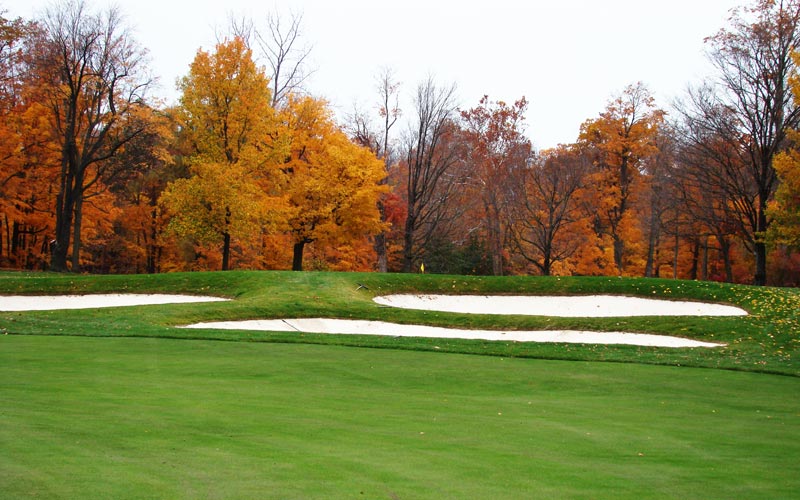
This bunker complex of three wide bunkers cut into a landform was restored in 2002. To see the putting surface, the golfer needs to either carry past it in two or layup long down the left side of the fairway. Either way, there is much to accomplish on one’s second shot, unusual for many par fives.
Ninth hole, 190/165 yards; Tom Doak thought this and the seventeenth to be the course’s two standout holes when he went around the course in 1986. Taken as a set, the par threes at The Country Club are exceptional, yet this is the only one where water is the primary challenge. Improvements in agronomy from Flynn’s day have only helped this hole as the bank that leads away from the green and toward the creek can readily be maintained in a tight, firm manner.
Tenth hole, 400/385 yards; The Country Club’s back nine doesn’t plunge through a river valley a la Kirtland Country Club but that is not to imply that its ground contours aren’t full of interest. The three to seven feet undulations found in this fairway are nothing short of ideal for good golf.
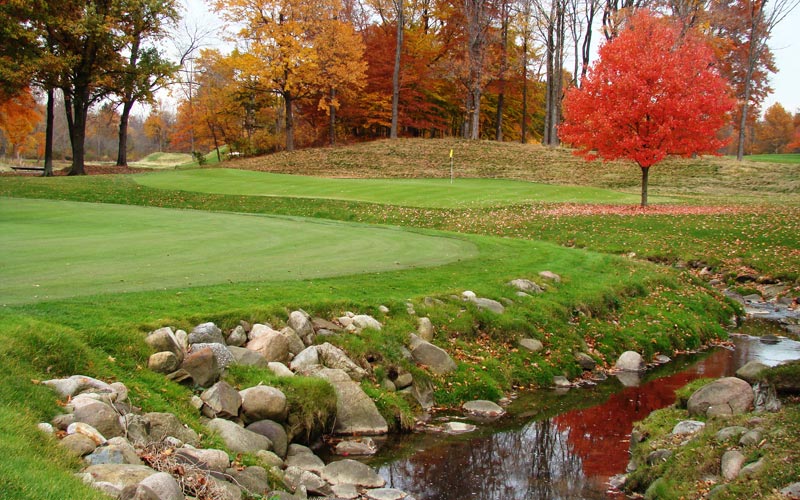
After crowding the ninth green with the creek, Flynn showed restraint at the tenth. Rather than put the green flush against it again, he pulled the green fifteen paces away and nestled it into the far hillside.
Eleventh hole, 185/160 yards; Be it the eleventh at Shinnecock Hills or the tenth at Rolling Green, Flynn had a knack for cutting bunkers into the landforms to make uphill par three holes still be fun to play. The harder hole locations are invariably toward the front as such holes feature greens with fierce back to front tilt. Can the golfer drop his tee ball just over the fronting bunkers and still enjoy an uphill putt?
Fourteenth hole, 215/165 yards; As seen at many of his best designs, Flynn was a true admirer of the playing characteristics of the Redan hole. Here is The Country Club’s version, which true to the rest of the layout is a more a lay-of-the-land version versus a heavily fortified (i.e. artificial) one.
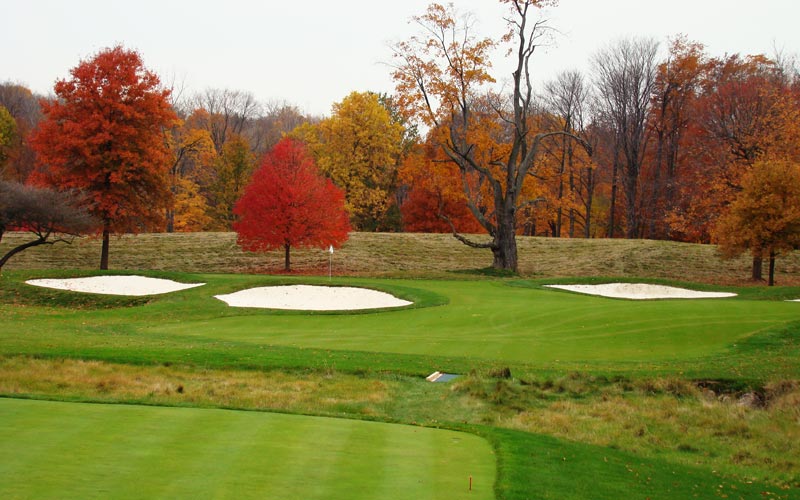
A draw at the tree that has shed most its leaves is the perfect play as the tee ball will hit and trickle down the right to left slope toward the day’s hole location. Note the grassing schemes by Mabie that are starting to lend The Country Club great texture.
Fifteenth hole, 455/415 yards; Among the Golden Age architects, Donald Ross was the most prolific at building eighteen hole courses and his name appears on over 400 courses. However, a significant gap in quality is evident between the courses Ross personally visited versus the courses that he routed from afar using a topography map. Though the courses that he never visited ended up with appealing routings that featured tees and greens occupying the high points, the courses themselves are more pleasant than memorable. Without attacking the landforms in every possible manner, opportunities were lost to create holes of distinction. Such is simply not true when discussing Flynn’s much smaller body of work. Given that he worked on only forty eighteen hole original designs (i.e. ninety percent less than Ross), Flynn’s best work always delivers several holes of outstanding character that seem fresh and unique to the particular site. This and the seventeenth are two such holes. Here at the fifteenth, Flynn has the golfer play his tee ball to a lower island of fairway before playing over three cross hazards and stepping up to the next tier where more fairway and the green itself is found. This thoroughly original hole helps The Country Club standout in the golfer’s mind from so many other parkland courses.
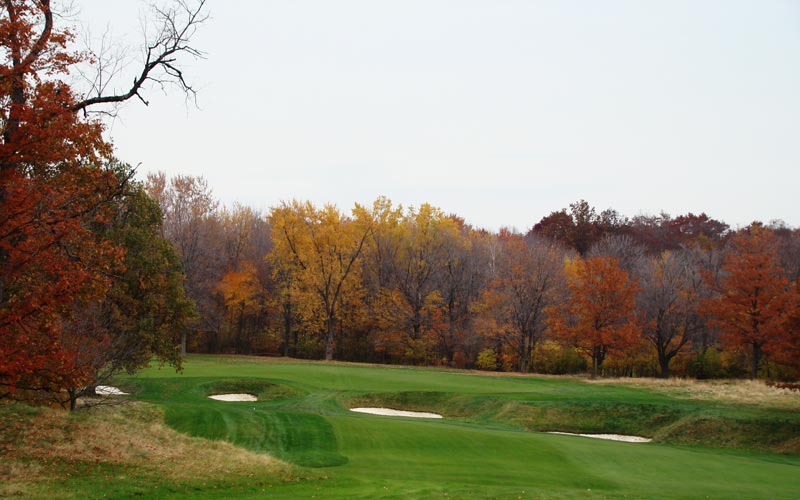
A mighty hole, a good drive is imperative on this dogleg left as otherwise the golfer might have to lay up in front of the cross bunkers that are 120 yards from the green.
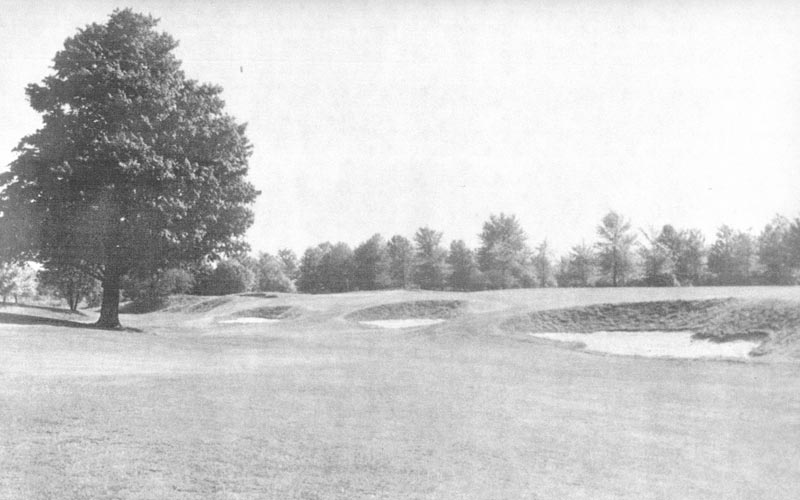
As seen from 1935, not a lot has changed to Flynn’s design at The Country Club – and that’s a very good thing.

Though the cross hazards obscure a view of the putting surface from the fairway’s lower level, this aerial view shows that the green is open in front and approach shots can be bounced in.
Seventeenth hole, 385/340 yards; In terms of using the slope of the ground, no architect has ever been clearly better than Flynn. Here is another example of the virtue of Flynn’s work ethic whereby he only worked on several commissions at a time, thus allowing him to slowly tease the best attributes from the property. If he was busy stamping out course after course, this hole would likely never have come into being as time was clearly required to find it and to figure out how to drape a fairway/hole over the heaving landforms along the edge of the property. Flynn historian Wayne Morrison, who has seen and studied more Flynn courses than anyone, considers this to be one of Flynn’s true standout holes. Morrison appreciates how the seventeenth ‘cannot be overpowered (think of how many Flynn hole designs are of this sort!) and how best to play the hole must be carefully considered as the canted offset fairway requires the golfer to gauge both line and distance in a way that leaves the best approach angle (with non-comittant visibility) into the demanding green complex.’
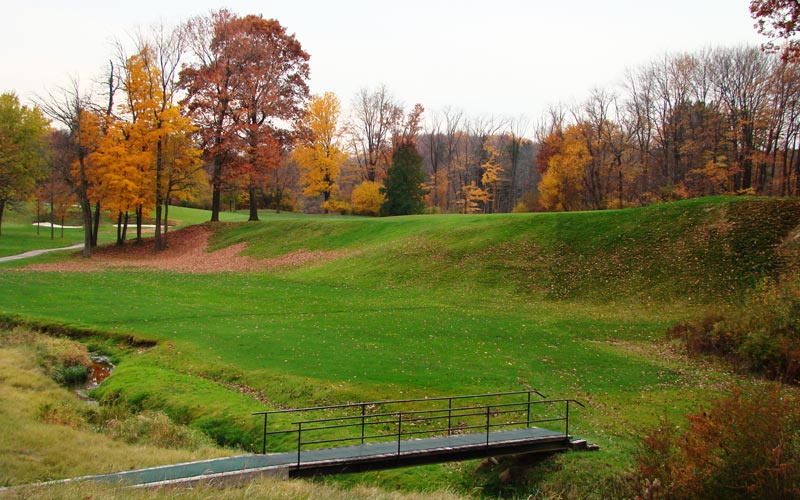
A slinging hook will carry this embankment and send one’s tee ball rolling for another forty yards from where…
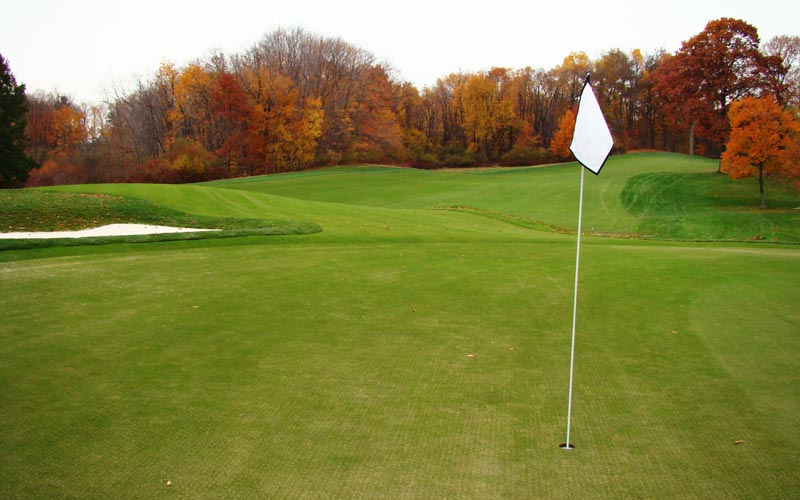
As taken two days after fall aerification, this view back down the seventeenth fairway highlights the wonderful landforms and Flynn’s genius at incorporating them into this hole.
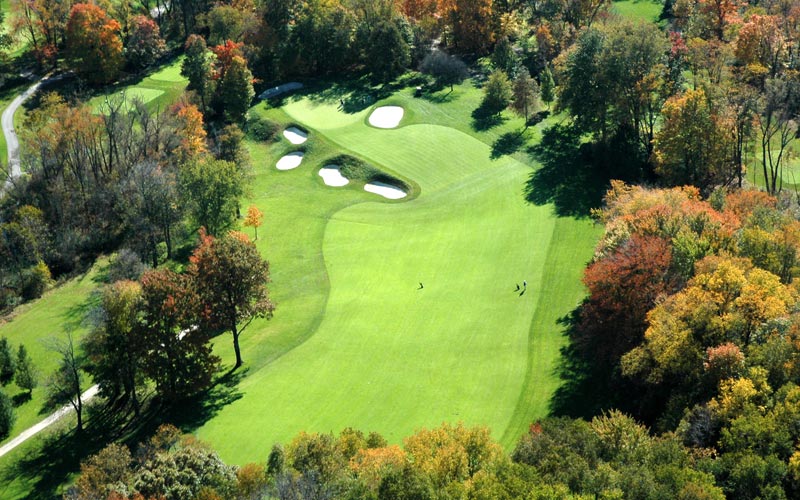
As this aerial of the last 150 yards of the seventeenth shows, Flynn’s ability to create interesting playing angles is second to none.
Eighteenth hole, 450/395 yards; There is no such thing as a great golf course that is constricted and tight and The Country Club is certainly far from that, especially thanks to all the good work that has occurred here of late. Indeed, The Country Club enjoys a sense of spaciousness rarely found and the golfer is encouraged to make bold, positive swings throughout the round. Thus, the sudden appearance of white stakes signifying out of bounds tight down the right jangles the golfer’s nerves, making the final tee ball one of the more frightening ones on the course.
Morrison perfectly summarizes the charm of Flynn’s work at The Country Club when he writes, ‘Its routing merits close attention as it demonstrates Flynn’s mastery in sequencing eighteen holes using natural features to create interest rather than forcing features on the landscape to provide interest. The resulting varied strategic implications from his use of natural features are evident, making The Country Club a wonderful example of the best of Flynn. Anyone wanting to study Flynn should make it a point of visiting here.’
Over the decades, The Country Club has been very kind to amateur golf and once again, it will take center stage when it hosts the 2012 United States Women’s Amateur. Everyone wins when a course of this magnitude is re-introduced to the public’s eye as it reminds one just how great the game can be. As spectators and players will find, the course will be presented in a manner that is every bit as good as at any point in its illustrious history.
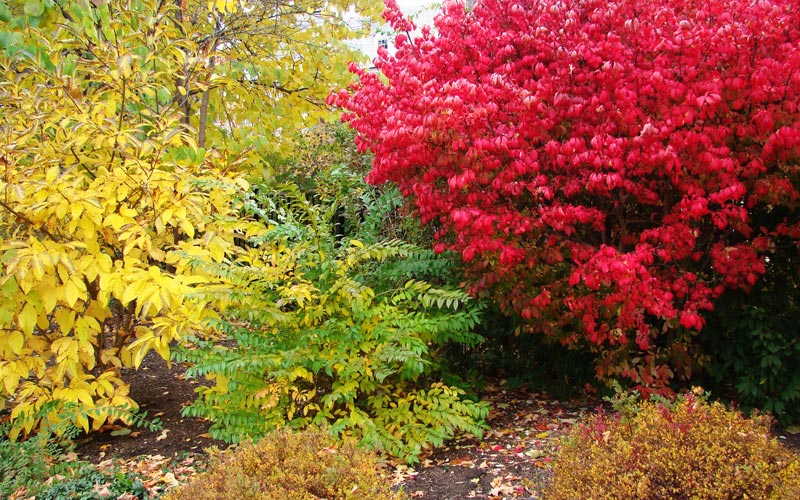
The ample grounds at The Country Club are well loved and cared for and there is no better time to go for a stroll (with or without clubs) than in the fall.
The End


